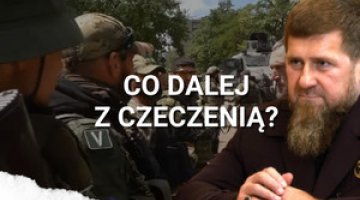More attacks on Kyiv. Day 312 of the war

On 31 December, the Russians launched a missile attack in north-western Ukraine. Prime Minister Denys Shmyhal reported that civilian residential infrastructure in Kyiv was the main target, but a thermal power plant was also hit, among other sites. Ukraine’s defence forces reported that they had shot down 12 of the 20 cruise missiles launched. Military units in the Chernihiv oblast, as well as Kramatorsk, Lyman, Mykolaiv and Zaporizhzhia were also hit by rockets on the same day (the Russians fired 31 missiles during the day). Russia had been attacking with kamikaze drones since the start of the year. Their main target was the Ukrainian capital, but the city defence reported having shot down all the drones involved: 45 on the night of 31 December to 1 January, and 39 on the next night. Nevertheless, further damage was caused in Kyiv, including to a power infrastructure facility. Other targets around Ukraine included Dnipro and Mykolaiv; in the latter a power cut halted the work of the pumping station, and thus water supplies to the city. On 1 January, Ukraine’s head of military intelligence Kyrylo Budanov stated that the aggressors had only been able to launch two massed rocket attacks.
The Russian artillery and air force are continuing to attack the positions and resources of Ukrainian forces along the frontlines and in the border areas. The shelling and bombardment of Kherson (from a dozen to several dozen attacks per day), Nikopol and the vicinity of Ochakiv, as well as the border areas of the Sumy oblast, have been particularly intense (at least 100 strikes per day). The Ukrainian artillery and air force attacked the positions and resources of the enemy troops in the Donbas and Zaporizhzhia oblast; they also hit targets on the Russian side of the border in Belgorod city and Bryansk oblast. The Ukrainian army’s Centre for Strategic Communications reported that 400 Russian soldiers had been killed and 300 wounded in an attack carried out on New Year’s Eve on a base in the occupied town of Makiivka near Donetsk. Further acts of sabotage took place in Melitopol and, according to unconfirmed reports, at the military airfield in Voronezh.
The invading forces attacked defensive positions along the Bakhmut-Siversk railway line (Krasna Hora, Rozdolivka), while flanking Soledar, the main point of Ukrainian resistance northeast of Bakhmut. Fighting continued in the eastern part of the town and in its north-eastern and southern outskirts, as well as west of Horlivka, north and south of Avdiivka, and west of Donetsk (mainly for control of Marinka). The Russians also made further attempts to break through the Ukrainian positions between Kreminna and Lyman and on the border of the Kharkiv and Luhansk oblasts. In Zaporizhzhia oblast there was fighting south of the town of Huliaipole: Russian troops approached the town and occupied the village of Dorozhnianka, which had previously been in no-man’s-land.
On 2 January Oleksiy Hromov, the deputy chief of the Main Operational Directorate of the General Staff of the Ukrainian Armed Forces, gave his assessment of the situation on the frontline. As of the end of 2022, the Armed Forces of Ukraine had liberated 40% of the territories seized by Russia after 24 February: about 40,000 km² in Kherson oblast, 14,000 km² in Chernihiv and Sumy oblasts, 12,000 km² in Kharkiv oblast and 7000 km² in the northern part of Kyiv oblast. According to Hromov, more than 20,000 Ukrainian servicemen received general military and specialist training outside the country last year. This was conducted mainly in Poland, the Czech Republic, Slovakia and at US Army facilities in Germany.
On 31 December, the Ukrainian Ministry of Internal Affairs reported that 108 enemy sabotage and reconnaissance groups had been discovered since the beginning of the Russian invasion. At the same time, 2220 criminal proceedings had been initiated concerning alleged cooperation with the special services of the Russian Federation, and more than 1880 people believed to have participated in sabotage activities had been detained. Since February 2022, Russian attacks have damaged more than 700 items of critical infrastructure.
On 30 December, Prime Minister Shmyhal said that the first tranche of the third batch of Starlink communication system terminals had arrived from Poland. The Prime Minister did not specify how many terminals Ukraine would receive as part of this package, merely emphasising that the aid will be very substantial. According to the Ukrainian Ministry of Digitisation, Poland will provide a total of more than 20,000 Starlink terminals (after counting those that already reached Ukraine last year), which will keep the population online at ‘points of invincibility’ throughout the country, as well as at medical facilities and energy infrastructure sites.
During President Vladimir Putin’s visit to the headquarters of the Southern Military District in Rostov-on-Don on 31 December, it was reported that the 1st Donetsk Army Corps (AC; formerly the so-called Donetsk People’s Militia), the 2nd Luhansk-Severodonetsk Guards’ AC (a.k.a. the Lugansk People’s Militia), and the Donetsk higher combined arms command school were formally incorporated into the Russian Armed Forces. Putin urged the participants in the so-called special military operation “to move only forward”.
Commentary
- The repeated attacks on Kyiv over the past few days are one more element in the Russian war of attrition: like the continued shelling of Kherson, the intention is to break the Ukrainian will to resist. The aggressors are also trying to demonstrate that they still have the capability to launch attacks, despite Ukrainian reports that Russian armaments (especially cruise missiles) are running out. It is counterproductive for Ukraine to declare, as it has done over recent days, that their air defences have been 100 per cent effective while at the same time confirming further Russian strikes (especially on elements of energy infrastructure) and the resulting power cuts.
- By officially incorporating the former Donetsk and Luhansk People’s Militias into the Russian army, Moscow broke with the fiction maintained since 2014 that the 1st and 2nd ACs were separate bodies from the Russian Armed Forces (it made little sense to continue this after these two Ukrainian oblasts were illegally incorporated into Russia). However, this move is unlikely to change the Kremlin’s policy regarding recruiting for and equipping the two bodies. Since the beginning of the war, the Russians have been carrying out permanent mobilisation in the Donbas, and the subunits recruited as a result have been equipped with a mixture of the oldest post-Soviet types of weaponry and military equipment, including some acquired from outside Russia (including Belarus). The units from these two oblasts make up a significant part of the Russian military effort, and they are most likely to have borne the brunt of the aggressors’ losses. It is worth noting that recruitment to the (pro)Russian armed formations in the occupied parts of the Kherson and Zaporizhzhia oblasts has not so far had any significant success.





